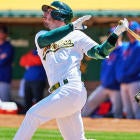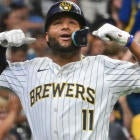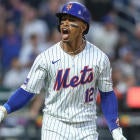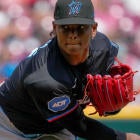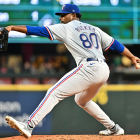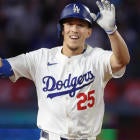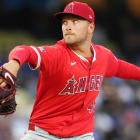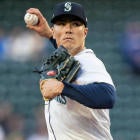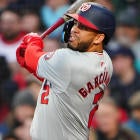If it wasn't already clear, this is officially The Year of the Rookie. Kyle Schwarber made it official Tuesday night.
Schwarber put together one of the best games by any player this season last night, clubbing a two-run homer in the ninth inning to send the game to extras, where he promptly won it in the 13th with another long ball. The 4-for-7 performance brought his season line to .429/.455/.738 in 12 games, and he probably isn't even the best rookie on his own team.
Schwarber entered the season as the Cubs third or fourth-ranked position prospect, but his hitting ability has his value skyrocketing. Fantasy owners who took a chance on him are enjoying the fruits of that decision, though he is by no means the only impact rookie out there.
For Fantasy owners in yearly re-draft leagues, judging the value of any rookie is pretty easy; they are useful as long as they are useful. You want Schwarber on your team because he is helping right now, but if he goes into a deep slump, there is little downside to cutting him.
Those of you in dynasty leagues have a very different outlook. Even if a rookie isn't quite blowing you away today, the potential for him to emerge as a star down the road makes him infinitely more valuable than his current production. With such a deep rookie class, there are plenty of valuable pieces out there, and sorting through them is tough. With many Fantasy leagues getting ready for their trade deadlines, here are the top-20 rookie-eligible players in order of long-term Fantasy value moving forward.
1. Carlos Correa, SS, Astros (20 years old)
Since making his debut June 8, Correa has been the top shortstop in Rotisserie Fantasy scoring, ranking No. 1 in home runs and RBI; he is just No. 4 in runs scored. Oh, and he ranks fourth in baseball among all players in batted balls over 100 MPH in that time frame, per BaseballSavant.com. He might be one of the best hitters in baseball before long, and he plays the shallowest position in the league.
2. Kris Bryant, 3B, Cubs (23)
Strikeouts have predictably been an issue for Bryant, who hasn't quite brought the elite power we expected from him yet. However, he hits a ton of fly balls and generates hard contact consistently -- 26th in the majors in hard-hit average -- so the power will come. He has Giancarlo Stanton upside.
3. Joc Pederson, OF, Dodgers (23)
The batting average might never be there with his strikeout rate, and Pederson has been a shockingly poor base runner so far. However, he draws a ton of walks, leads off for an amazing offense, and is already one of the best power hitters in the game -- his average home run distance of 430.5 feet is more than 10 feet farther than the next closest player, per HitTrackerOnline.com. That rare power makes him stand apart, especially since it could come with 20 stolen bases down the line.
4. Noah Syndergaard, SP, Mets (22)
Even after walking five batters in five innings Wednesday against the Nationals, Syndergaard still has just a 2.3 BB/9, a very manageable number for a young pitcher. Especially one who strikes out 9.4 per nine and throws as much gas as he does. He could end up being the best of the Mets' young pitching core.
5. Byron Buxton, OF, Twins (21)
Throw out Buxton's aborted major-league debut, which saw him struggle before succumbing to injury. Buxton has eventual 20-homer upside, but should steal 40 bases with double-digit triples, tons of runs and a high batting average until he gets there.
6. Joey Gallo , 3B, Rangers (21)
If you want Gallo ahead of Buxton, go right ahead. His ceiling is probably higher, thanks to his pretty much unmatched power potential -- it's Giancarlo Stanton and him, basically. However, if we're looking at the next five years, there is a higher chance of Gallo flaming out due to his alarming strikeout tendencies.
7. Steven Matz, SP, Mets (24)
You know that thing about how Syndergaard could end up the best of the young pitchers in the Mets' rotation? I might actually bet on Matz, who was significantly better than Syndergaard, Matt Harvey, Jacob deGrom and Zack Wheeler at Triple-A. However, he is a few years older than Syndergaard and has more of an injury history to worry about.
8. Kyle Schwarber, C, Cubs (22)
Schwarber was considered a bit of a reach at No. 4 in last year's draft, but he was laughably dominant in the minors, putting up a .333/.429/.613 line with 34 home runs and 73 extra-base hits in his first 147 games as a professional. He should see enough time at catcher over the next few years to maintain his eligibility, even if it isn't his long-term home. This ranking, aggressive as it is, might actually be underselling him.
9. Miguel Sano, 3B, Twins (22)
Another player who could make this ranking look laughably pessimistic before long. He might be right behind Gallo in the power potential department, and probably has a more well-rounded hit tool.
10. Maikel Franco, 3B, Phillies (22)
Franco might not have the upside of some guys behind him on the list, but he seems like a very safe option; he has solid power, but doesn't have to sell out at the expense of his plate discipline for it. He should be a solid contributor in average and power.
11. Addison Russell, SS, Cubs (21)
Russell's first taste of the majors hasn't gone as hoped, as he has struggled badly with his strikeout rate. On the other hand, he's not even 22 and was more highly regarded coming into the season than anyone on the list except Buxton and Bryant and plays the hardest position to fill in baseball.
12. Lance McCullers, SP, Astros (21)
This is a very aggressive ranking for a pitcher who posted a 5.47 ERA last season and wasn't even a top-100 prospect coming into the season. On the other hand, he has elite stuff and has curbed the control problems that plagued him in the minors, so it's not crazy.
13. Andrew Heaney, SP, Angels (24)
Another very aggressive ranking, as Heaney managed an abysmal 5.83 ERA in 29 1/3 major-league innings last season. However, his return has gone much better, with an increase in strikeout rate to go along with his expected elite control. He is a very safe keeper, though the upside isn't considerable.
14. Jorge Soler, OF, Cubs (23)
Soler's star has taken a bit of a hit, as he has just five home runs in 62 games this season; he had that many in 24 games last season. His power hasn't played up as much as expected, and strikeouts are a big concern, however he also ranks 12th in the majors in hard-hit average, so the power will come.
15. Eduardo Rodriguez, SP, Red Sox (22)
Things have gone south quickly for Rodriguez, who now owns a 4.64 ERA through his first 10 starts. However, he had a 2.10 ERA in his first 14 starts in the minors for the Red Sox, and still brings a mid-90's fastball from the left side, a nice starting point for any pitcher.
16. Carlos Rodon, SP, White Sox (22)
Like Rodriguez, Rodon has a pretty terrific "Dominant Starting Pitcher" starter kit, armed as he is with a mid-90's fastball and a slider that could be one of the best pitches in baseball. He needs to learn to command his stuff, and could use a third pitch, but the upside remains tremendous.
17. Devon Travis, 2B, Blue Jays (24)
Travis may be the single hardest player to pin down on this list. His minor-league track record suggests a very good knowledge of the strike zone and 15-15 potential, but has been pretty lackluster since the end of a very good April. There is enough here to like, but his ceiling is unclear.
18. Aaron Nola, SP, Phillies (22)
Nola and Heaney might be mirror images of each other, but Heaney's longer track record gives him the edge. Neither has ace upside, but they should be relatively safe inning eaters.
19. Chris Heston, SP, Giants (27)
Little in Heston's track record suggests he has even the upside he's shown this season, but his production so far is awfully hard to ignore. If you take out two starts in Colorado, this is what his season looks like:
17 GS, 108 IP, 2.50 ERA, 1.06 WHIP; 7.4 K/9, 2.4 BB/9, 0.2 HR/9
The Giants have a history of getting the most out of unimpressive pitchers, and you have to buy into this at least a little.
20. Rusney Castillo , OF, Red Sox (28)
Due to his advanced age, we don't have much time to wait for Castillo to prove himself. He was very impressive in a 10-game cameo last season, but did nothing with 26 games this time around. His .281/.333/.390 line at Triple-A doesn't inspire much confidence either.
"Wait, how can you leave off ______?????"
Yasmany Tomas, OF/3B, Diamondbacks (24)
Tomas' .303/.339/.431 line is pretty impressive, but the power hasn't been there like we thought it would be. At 25 this offseason, he doesn't have much time to develop into the player he will be down the road, but a power surge down the stretch would help his prospects. If you want to slot him in ahead of Castillo, I won't protest.
Michael Taylor, OF, Nationals (24)
Taylor broke out with a 23-homer season between Double-A and Triple-A last season, but that power hasn't translated so far in the majors. He might have 15-30 potential, but his contact issues might make him more of a Mike Cameron type of player down the road.
Vincent Velasquez, SP, Astros (23)
Because they have mostly pitched at the same levels and made their debut only a few weeks apart for the Astros, Velasquez is always going to be compared to McCullers. That comparison hasn't made Velasquez look great so far, but his minor-league track record is a lot more promising than McCullers', and he might end up the better pitcher when it's all said and done. Let's just say I'm happy I didn't give up on him in my keeper league after a few rough starts.
Steven Souza, OF, Rays (26)
Souza has played 80 games this season, and is on a 30-homer, 20-steal pace over 162 games, which is terrific. However, he is also flirting with the Mendoza line and has the second-highest strikeout rate of the last 50 years. At 26, Souza probably is who he is.







